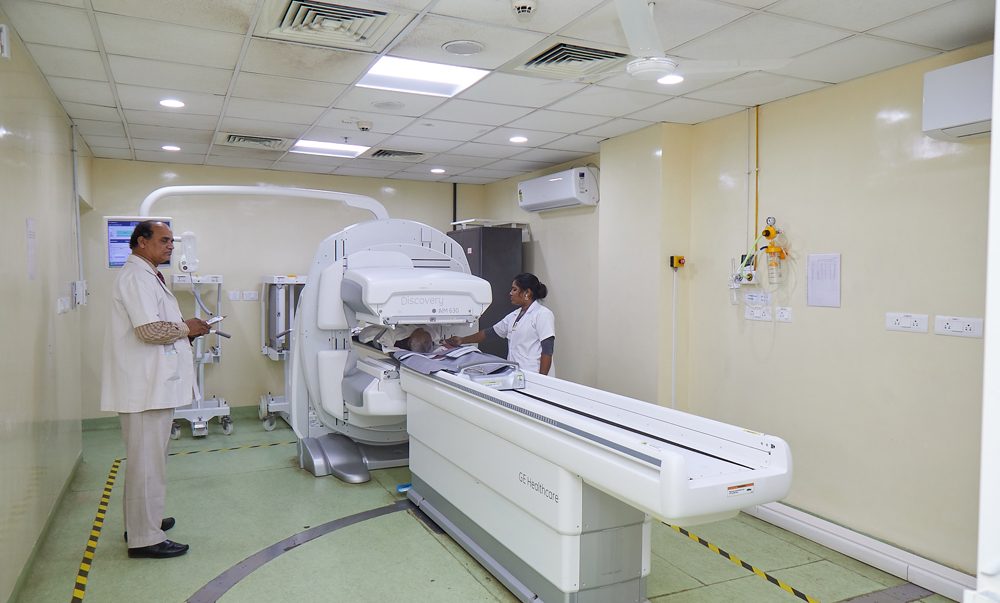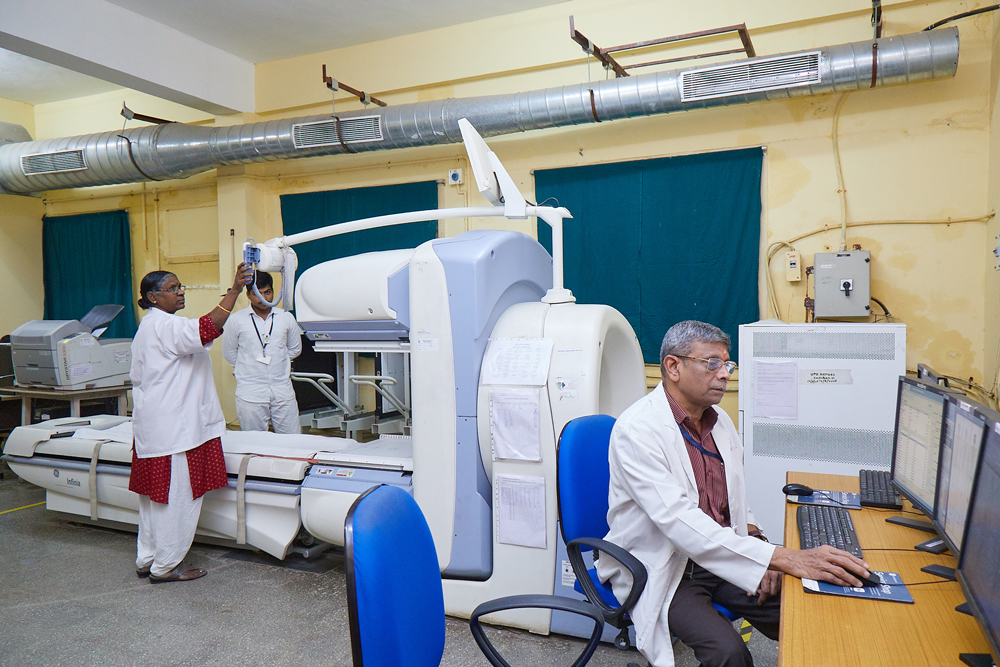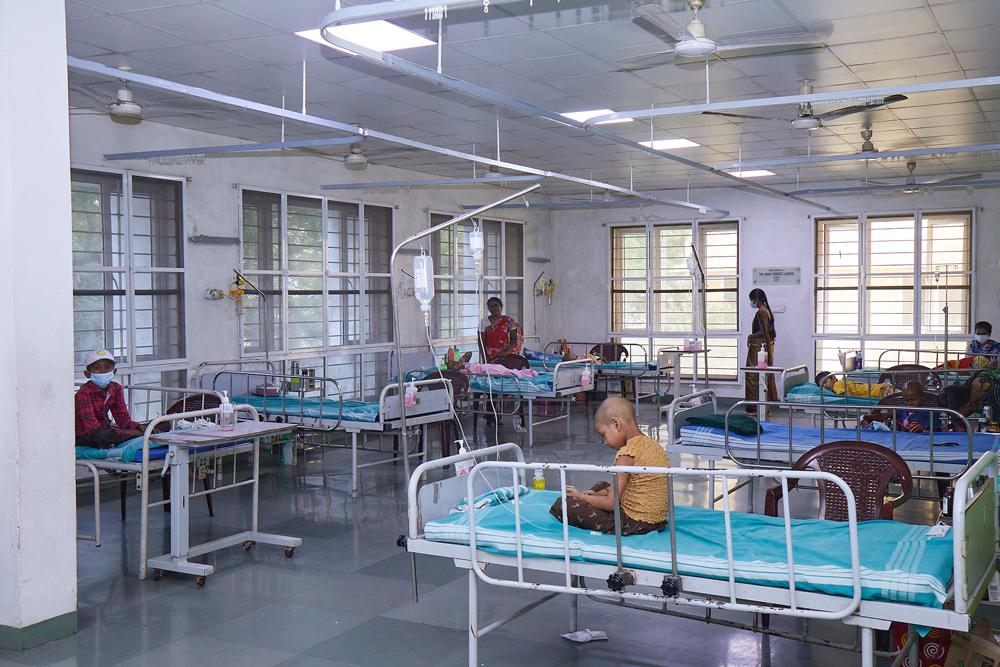Nuclear medicine uses radionuclides both for Diagnosis by Internal administration for therapeutic purposes.

The department of Nuclear Medicine at the institute was started in November, 1957 headed by Dr.V.M.Sivaramakrishnan, M.A., Ph.D., D.R.I.P (Oak Ridge). Dr.Taylor, and Dr.V.K.Iya from Atomic Energy Establishment, Trombay visited this department to gather information for starting their Isotope Division. The Atomic Energy started supplying radioisotopes from 1961 onwards four years after the Nuclear Medicine department was started at Cancer Institute. Radioactive iodine and radioactive gold, imported from Harwell, UK were routinely used in the diagnosis and treatment of certain cancers. Dr.V.M.Sivaramakrishnan initiated major research programs involving the use of various radioisotopes with chelating agents in order to study the metabolic pathways in biological systems in both health and disease.
Nuclear medicine, related to oncology, nuclear oncology involves the uses of small amount of radioisotopes for study of organ function – functional imaging.
The availability of various radionuclides, have revolutionized the practice of medicine, during the last fifty years. Radionuclides have been successfully employed in clinical diagnosis and treatment. Though early progress was restricted by the limited choice of radio nuclides, by 1946 after the Second World War lot of isotopes was available for medical uses.
Radionuclides are used in four important ways in medicine (a) Diagnosis (b) Internal administration for therapeutic purposes (c) Brachytherapy and (d) Teletherapy sources for production of gamma ray beams.
The amount of radioactive material used weighs about 10-10 g; this means that studies can be carried out without any chance of the test method affecting the system being investigated.
In nuclear medicine clinical information is derived from observing the distribution of a pharmaceutical administered to the patient. In-vivo imaging is the most common type of procedure in nuclear medicine, nearly all images being carried out with a gamma camera. It offers the potential, unique among imaging techniques, of demonstrating function rather than simple anatomy.
Please feel welcome to contact our friendly reception staff with any general or medical enquiry call us.
To relate the beginning of nuclear medicine is to trace a convergence of many other scientific disciplines, with those of medicine, to illustrate the interdependence of basic science, medicine and technology and indeed to suggest that such electricism may well be a prophetic model of future advances in all fields of medicine.
Today the science and technology of nuclear medicine are used to solve problems involving every organ system of the body. The field can be thought of as “Topographic Physiological Chemistry” that is, in-situ chemistry. No field is better able to apply advances in molecular biology and genetics to the care of the sick and to biomedical research. In the perspective of the patients’ problem, the technological advances such as Positron Emission Tomography, Single Photon Emission Tomography, advanced image processing, information and large numbers of new physiological tracers, help in their solution.




The amount of radiopharmaceutical used is carefully selected to provide the least amount of radiation exposure to the patient but ensure an accurate test
Nuclear Medicine studies involve the use of small amount of radioactive isotopes administered into the body.
It is mainly used to detect the spread of cancer to the bones especially in cancer of breast, prostate, thyroid & lung.
The functions of organs like kidney, liver and brain are also being studied by the isotopes.
We also use similar isotopes for studying the function of thyroid gland.
Radioactive iodine is used to detect the spread of cancer into other organs.
We also use such isotopes for the treatment of the similar spread to other organs.
Observership Training given for post graduates of M.Sc [Medical physics] of Govt.Arignar Anna Cancer Hospital, Karapettai, Kanchipuram in our nuclear medicine department for a period of 1 month in 2 batches from since 2013 as a part of their Internship programme.
| NAME | EDUCATIONAL QUALIFICATION | DESIGNATION |
| Dr. R. Krishna kumar | M.D., DMRT, DRM, Ph.D | Professor and Head | Mr. G.K. Rangarajan | M.Sc., ANMT, RSO | Scientific Assistant cum Technologist |
| Mrs. N.Anandi | DMLT, B.Sc [NMT] | Technician |
| Mr.Kuncha Ramesh | DMLT | Technician |
| NAME | EDUCATIONAL QUALIFICATION | DESIGNATION |
| Mr.N.Parvathi Nathan | B.sc N.M.T (3rd Year) | Student |
| Miss.S.Lavanya | B.sc N.M.T (3rd Year) | Student |
| Mr.V.Sandilyan | B.sc N.M.T (2nd Year) | Student |
| Miss.D.Divya | B.sc N.M.T (2nd Year) | Student |
| Miss.SyedAzheemunnisa | B.sc N.M.T (1st Year) | Student |
| Miss.U.Jayanthi | B.sc N.M.T (1st Year) | Student |
| Mr.R.Sridhar | B.sc N.M.T (1st Year) | Student |
| Mr.H.GokulDass | B.sc N.M.T (1st Year) | Student |
Please feel free to contact our friendly staff with any medical enquiry.